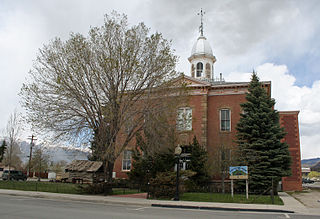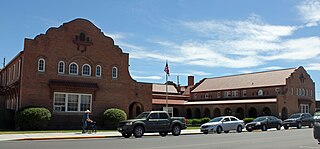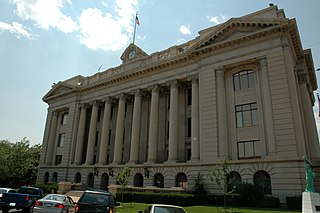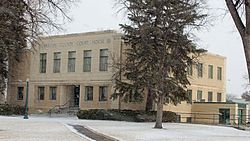
The Old Baker County Courthouse, now the Emily Taber Public Library, was built in 1908. It is at 14 McIver Avenue West in Macclenny, Florida. It was designed by Edward Columbus Hosford of Eastman, Georgia. In 1986 it was added to the U.S. National Register of Historic Places.

The Woodbury County Courthouse is located at 620 Douglas Street in Sioux City, the county seat of Woodbury County, Iowa, United States. It is regarded as "one of the finest Prairie School buildings in the United States" and has been declared a National Historic Landmark for its architecture. It is used for legal proceedings in the county.

Cripple Creek Historic District is a historic district including Cripple Creek, Colorado, United States and is significant for its gold mining era history. It developed as a gold mining center beginning in 1890, with a number of buildings from that period surviving to this day. The mines in the area were among the most successful, producing millions of dollars of gold in the 1890s and supporting a population of 25,000 at its peak. It was declared a National Historic Landmark in 1961.

The Dallas County Courthouse, built in 1892 of red sandstone with rusticated marble accents, is a historic governmental building located at 100 South Houston Street in Dallas, Texas. Also known as the Old Red Courthouse, it became the Old Red Museum, a local history museum, in 2007. It was designed in the Richardsonian Romanesque style of architecture by architect Max A. Orlopp, Jr. of the Little Rock, Arkansas based firm Orlopp & Kusener. In 1966 it was replaced by a newer courthouse building nearby. On December 12, 1976, it was added to the National Register of Historic Places. In 2005–2007 the building was renovated.

The Chowan County Courthouse is a historic courthouse in Edenton, the county seat of Chowan County, North Carolina. Built in 1767, it is one of the finest examples of public Georgian architecture in the American South. It was declared a National Historic Landmark in 1970.

The Cheyenne County Courthouse in Cheyenne Wells, Colorado is a Georgian Revival-style building that was built in 1908 and first used in 1909. It was listed on the National Register of Historic Places (NRHP) in 1989.

Morris County Courthouse is located on Washington Street between Court Street and Western Avenue in the town of Morristown in Morris County, New Jersey. The courthouse was built in 1827 and was added to the National Register of Historic Places on August 19, 1977, for its significance in architecture and politics/government. It was added as a contributing property of the Morristown Historic District on November 13, 1986.

The Greene County Courthouse, located in Jefferson, Iowa, United States, was built in 1918. It was individually listed on the National Register of Historic Places in 1978 as a part of the County Courthouses in Iowa Thematic Resource. In 2011, it was included as a contributing property in the Jefferson Square Commercial Historic District. The courthouse is the third structure to house court functions and county administration. The courthouse features the Mahany Tower, a 120 feet bell tower.

The Cimarron County Courthouse is the historic courthouse serving Cimarron County, Oklahoma, located in Boise City. The courthouse was designed by M.C. Parker in the Classical Revival and Neoclassical styles and built in red brick by Strong & Froman. The building opened in 1926 after the previous wood-frame courthouse burned down. The courthouse is surrounded by a traffic circle that has several highways in a unique example of concurrency, including US-56, US-64, US-287, US-385, US-412, State Highway 3, and SH-325. The highways lead to different locations including north to Colorado, northeast to Kansas, west to New Mexico, and southwest to the Texas Panhandle. On August 23, 1984, the courthouse was added to the National Register of Historic Places.

The Sedgwick County Courthouse, located at 315 Cedar St. in Julesburg, Colorado, was built during 1938-39 by the Works Progress Administration (WPA). It was listed on the National Register of Historic Places in 2007; the listing included two contributing buildings.

The Bent County Courthouse and Jail, of Bent County, Colorado, at 725 Carson Ave. in Las Animas, was built in 1887. It was listed on the National Register of Historic Places in 1976; the listing included two contributing buildings.

The Prowers County Building, at 301 S. Main St. in Lamar, Colorado, was built in 1928. It was a work of Robert K. Fuller and of A.E.Danielson & Sons in Classical Revival style. It served as a courthouse and has also been known as Prowers County Courthouse. It was listed on the National Register of Historic Places in 1981.

The Chaves County Courthouse, located on the 400 block of Main Street in Roswell, New Mexico, is the center of government of Chaves County. The courthouse was built in 1911 after Roswell's citizens learned that New Mexico would become a state the next year. Isaac Hamilton Rapp, of the Colorado firm I.H. and W.M. Rapp, designed the courthouse in the "monumental civic" adaptation of the Beaux-Arts style. A cupola with green tiles tops the courthouse.

The Chaffee County Courthouse and Jail Buildings, at 501 E. Main St. in Buena Vista, Colorado, were listed on the National Register of Historic Places in 1979.

The Logan County Courthouse in Sterling, Colorado was built in 1910. It was listed on the National Register of Historic Places in 1979.

The Park County Courthouse and Jail in Fairplay, Colorado was built in 1874. It was listed on the National Register of Historic Places in 1979.

The Alamosa County Courthouse, at 702 Fourth St. in Alamosa, Colorado, was listed on the National Register of Historic Places in 1995.

The Weld County Courthouse, at 9th St. and 9th Ave. in Greeley, Colorado, is a Classical Revival-style building built in 1917. It was listed on the National Register of Historic Places in 1978.

The Downtown Boulder Historic District, in Boulder, Colorado, is a 48 acres (19 ha) historic district which was listed on the National Register of Historic Places in 1980. Additional significance for the district was recognized in 2018 for association of the Boulder County Courthouse with events of 1975, when Boulder County clerk Clela Rorex issued marriage licenses to six same-sex couples.

The Boulder County Courthouse is a historic building on Pearl Street in Boulder, Colorado, built in 1933. The courthouse is a contributing property to the Downtown Boulder Historic District, listed on the National Register of Historic Places in 1980. In 2018, additional information about the building was added to the documentation of the district.






















